|
.
After Napoleon's humiliation of Prussia,
the Emperor turned his attention
to subduing his mighty Russian foe.
|

Introduction.
"He [Napoleon] saw, from Berlin, in front of him
the Russian armies - now preparing to meet him
as his principal adversary." - Loraine Petre
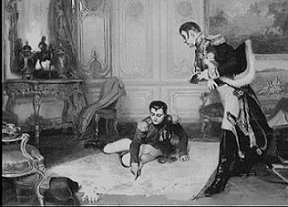 Negotiations between France, Britain and Russia, during the early months of 1806, broke down.
Prussia had been lashed to fury by the discovery that Napoleon had attempted to bribe Britain
with Hanover, which he had so recently ceded to Prussia.
Wishing to strike her before succour reach her from Russia, Napoleon anticipated her
ultimatum by marching against her towards the Elbe River.
Negotiations between France, Britain and Russia, during the early months of 1806, broke down.
Prussia had been lashed to fury by the discovery that Napoleon had attempted to bribe Britain
with Hanover, which he had so recently ceded to Prussia.
Wishing to strike her before succour reach her from Russia, Napoleon anticipated her
ultimatum by marching against her towards the Elbe River.
In August 1806, the Prussian king, made the decision to go to war independently of any other great power.
The Prussian ultimatum reached Napoleon on the 7th October.
Approx. 150,000 French soldiers moved with such speed that Napoleon was able to destroy
the fearsome Prussian army in two quick battles, Jena and Auerstadt.
These defeats were a heavy blow to the Fourth Coalition against Napoleon.
Coalition partners included Prussia, Russia, Saxony, Sweden, and Great Britain.
Napoleon entered into Berlin in October and visited the tomb of King Frederick the Great.
He instructed his marshals to remove their hats, saying, "If he was alive we wouldn't be here today."
The French army in 1807.
Napoleon hoped on finding the Russians
and defeating them in a pitched battle.
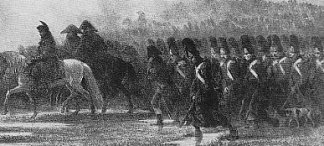 Loraine Petre described the French troops during the campaign in Eastern Prussia and Poland.
He wrote: "The rank and file of the army was but little, if at all, past its best.
In the earlier part of the campaign, its youngest men were the conscripts of 1806 who had, owing to their premature enrolment,
already undergone a years' training. Many of the troops had been with Napoleon in his
earlier campaigns and in Egypt, very many had been at Ulm and Austerlitz, the majority had just emerged from the
briliant campaign of Jena.
Loraine Petre described the French troops during the campaign in Eastern Prussia and Poland.
He wrote: "The rank and file of the army was but little, if at all, past its best.
In the earlier part of the campaign, its youngest men were the conscripts of 1806 who had, owing to their premature enrolment,
already undergone a years' training. Many of the troops had been with Napoleon in his
earlier campaigns and in Egypt, very many had been at Ulm and Austerlitz, the majority had just emerged from the
briliant campaign of Jena.
They were now preparing for a renewed war against fresh enemies; the hardest task
that an army can undertake. Even these hardened and enthusiastic warriors contemplated witg dread
the prospect of a fresh winter campaign in an inhospitable and difficult country,
and Napoleon was often remonstrated with, as he rode alongside of his men, for insisting on
their advance to Poland.
To such complaints he would reply with the rough jests
which his veterans loved to hear from him ... In action, the infantry was still splendid,
and did not as yet require to be formed in deep columns of many battalions,
such as was macdonald's at Wagram, three years later. The cavalry was excellent and well
mounted, though, in the latter respect, they fell short of many Russian cavalry regiments.
The artillery was highly trained and invariably made good practice."
(Petre - "Napoleon's Campaign in Poland, 1806-1807" pp 27-28)
The winter campaign in eastern Prussia and Poland exhausted the French troops mentally
and physically. They campaigned mostly in the wooded area and with few inhabitants,
virtually wilderness. It was with extreme difficulty that the artillery could be moved along.
At Eylau the French have suffered 15,000-25,000 killed and wounded, this is about 1/3 of
their forces. Riding over the battlefield one of the French commanders said: "Quel massacre
! Et sans resultat" (What a massacre! And for no outcome.)
The French soldiers cried out for peace after Eylau.
Eylau was the first serious check to the French Grand Armee, which in the previous two
campaigning seasons had carried all before it. In spring 1807 though the weather was still severe, Napoleon rousted his troops out
of their winter quarters for drills and frequent field exercises.
Meanwhile in France thousands of young men were called to arms. Napoleon caused these to
be despatched to the front as soon as possible and they were drilled en route.
The "First Polish War".
"... France's enemies happened to be
Poland's oppressors ..."
- Charles Summerville
The defeat of Prussian army in Jena and Auerstadt did not end the war.
Some Prussian troops survived the catastrophe and joined those stationed in
Eastern Prussia (today Mazury). The French followed them.
In late autumn the French troops marched into Poland. They moved through Poznan
(then Posen) and Kalisz.
"The topography of Poland was little known [to the French]. A survey detachment
directly under imperial headquarters was accordingly organized to which was entrusted
the task of mapping the country as the army advanced.
The instructions issued to these 'surveyors' are not without interest.
They were to move with the advanced guard of each corps and to send their work daily
to imperial headquarters.
Attention was especially called to the necessity for recording the name of each village -
this, one would think, was a somewhat superfluous instruction -
with its population and nature of soil. Each sketch was to be signed so that, if more
precise information was subsequently required by Napoleon, the officer concerned
could be readily summoned. The emperor complained later that it was to find on his maps
a place mentioned in a dispatch, and gave orders
that places named must have their locality plainly described." (- F.D. Logan)
Napoleon's army crossed the Vistula River in several points and turned north-east.
The French entered Eastern Prussia, inhabited by the Prussians and many Poles.
 Loraine Petre described the theatre of war: "... a country for the most part flat, marshy, and thickly wooded
- a country resembling, except in the last respect, the broads of Suffolk and Norfolk.
There are no heights of any importance, and it is only in the north-western corner ... that
it is possoble to describe the country as anything by an undulating plain.
Here the underying rock of the Polish plain crops out, and gives rise to hills which, in places,
reach the elevation of 500 to 700 feet above the sea, amongst which are imbedded the lakes
... "
Loraine Petre described the theatre of war: "... a country for the most part flat, marshy, and thickly wooded
- a country resembling, except in the last respect, the broads of Suffolk and Norfolk.
There are no heights of any importance, and it is only in the north-western corner ... that
it is possoble to describe the country as anything by an undulating plain.
Here the underying rock of the Polish plain crops out, and gives rise to hills which, in places,
reach the elevation of 500 to 700 feet above the sea, amongst which are imbedded the lakes
... "
The theater of war was wooded and it was impossible to find an area sufficiently clear of
continuous forest to allow of the deployment
of larger force. It was a difficult terrain for speedy maneuvers.
There were only few roads and even fewer cities. It was a good place to put 'population
explosion' in focus. :-)
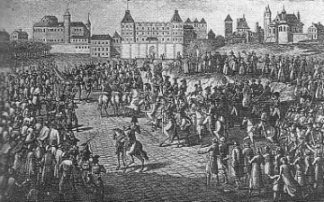 Marshal Murat entered Warsaw to a rapturous welcome.
He was feted by the Poles igniting vain hopes of future kingship.
"In the 16th century Poland had been one of the most powerful countries in Europe ...
within the space of 200 years, however, Poland had been eclipsed by its neighbours ...
Soon the country's history culture and language were extinguished and its very name abolished. In this way was the white eagle of Poland devoured
by the three black eagles of Prussia, Russia, and Austria. ... Meanwhile the Poles looked for
France, with its revolutionary ideas of Liberty,
Equality and Fraternity, as a beacon of hope. The fact France's enemies happened to be Poland's
oppressors was an obvious attraction, and many Polish soldiers volunteered for service in the
French army." (Summerville - "Napoleon's Polish Gamble" p 15)
Marshal Murat entered Warsaw to a rapturous welcome.
He was feted by the Poles igniting vain hopes of future kingship.
"In the 16th century Poland had been one of the most powerful countries in Europe ...
within the space of 200 years, however, Poland had been eclipsed by its neighbours ...
Soon the country's history culture and language were extinguished and its very name abolished. In this way was the white eagle of Poland devoured
by the three black eagles of Prussia, Russia, and Austria. ... Meanwhile the Poles looked for
France, with its revolutionary ideas of Liberty,
Equality and Fraternity, as a beacon of hope. The fact France's enemies happened to be Poland's
oppressors was an obvious attraction, and many Polish soldiers volunteered for service in the
French army." (Summerville - "Napoleon's Polish Gamble" p 15)
To the Polish deputations which approached him in Berlin and at Warsaw, he replied vaguely,
"France has never recognised the different partitions of Poland; nevertheless, I
cannot proclaim your independence until you have decided to defend your rights as a
nation with arms in your hands by every sort of sacrifice, even that of life. You have
been reproached with having, in your continued civil dissensions, lost sight of the
interests of your country. Instructed by your misfortunes, reunite yourselves and prove to
the world that one spirit animates the whole Polish nation."
Napoleon was furious with Marshal Murat, for forwarding one petition from Warsaw, in which
it was prayed that the Polish kingdom might be reconstituted under a French commander.
Napoleon's replies to Poles were sufficiently encouraging to assure to him the moral and
material support of the Poles in the ensuing campaign, and to deprive Prussia and Russia
of all hope of recruiting their armies by voluntary enlistment in Poland.
 Napoleon entered Warsaw in 1807 and French eagles soared over the Vistula. The Emperor
was hesitant about reenacting the Kingdom of Poland. In spite of the ovations given him
by the Poles, he wrote: "Only God can arbitrate this vast political problem ... It would
mean blood, more blood, and srtill more blood ..."
Napoleon entered Warsaw in 1807 and French eagles soared over the Vistula. The Emperor
was hesitant about reenacting the Kingdom of Poland. In spite of the ovations given him
by the Poles, he wrote: "Only God can arbitrate this vast political problem ... It would
mean blood, more blood, and srtill more blood ..."
But it was not long before
the Duchy of Warsaw became a bastion of France in central and Eastern Europe,
and Polish troops stood ready to fight for Napoleon and independence.
The war in 1807 was called by Napoleon the "First Polish War" and resulted
in the formation of the Polish state. The country was divided into departments.
The branches of justice, war, finance and police, were assigned to Polish government.
(In 1812 Napoleon, in an attempt to gain increased support from Polish nationalists and
patriots, termed the war against the Russian Empire the "Second Polish War.)
The Russians had been located and beaten at Eylau and Hoff. The rest of the winter and
spring passed in quietness. Napoleon had said that the army would go into winter quarters.
The army had to recover 60,000 wounded, missing and deserters. The hospitals were overcrowded.
The Emperor appreciated surgeons' hard work and rewarded them with promotions and money.
Reinforcements were on the roads from France. Napoleon decided to build a military camp in Osterode. The French engineers constructed a palisade
around a vast square inside which were streets bordered by wooden huts. Each street bore the name of one of the latest
victories. The Imperial Guard had its own camp, built with a degree of luxury. In the centre
was a brick building where Napoleon installed himself.
 The news from France were not good. The slaughter at Eylau (see picture) had had the worst effect.
The military police combed the rear areas to round-up deserters.
The news from France were not good. The slaughter at Eylau (see picture) had had the worst effect.
The military police combed the rear areas to round-up deserters.
Napoleon had begun to contemplate a renewal of the campaign so early as the end of April,
when he wrote Marshal Soult to send his sick to the rear, preparatory to a general advance.
All he needed was only the capture of Danzig, an important sea port and fortress
at the mouth of the Vistula River on the Baltic Sea. In Danzig were immense stocks of ammunition
and weapons. Danzig was defended by Prussian troops and few Russians and was also a threat to Napoleon's left flank.
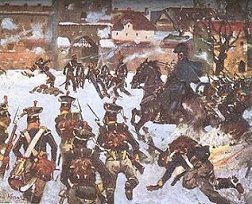 Georges Blond gave somehow misleading description of the siege of Dirschau.
Dirschau stands on the west bank of the Vistula protecting the approaches to Danzig.
"The Poles in the Grande Armee had wantonly wrecked the small town of Dirschau
because it had been defended by Prussians - only 500 of them, but General Dombrowski [sic] had first battered it with artillery.
Then the Polish troops had opened fire indiscriminately on both the enemy and the population.
Some houses remained miraculously intact amid the carnage." ( Georges Blond - "La Grande Armee"
p 146)
Georges Blond gave somehow misleading description of the siege of Dirschau.
Dirschau stands on the west bank of the Vistula protecting the approaches to Danzig.
"The Poles in the Grande Armee had wantonly wrecked the small town of Dirschau
because it had been defended by Prussians - only 500 of them, but General Dombrowski [sic] had first battered it with artillery.
Then the Polish troops had opened fire indiscriminately on both the enemy and the population.
Some houses remained miraculously intact amid the carnage." ( Georges Blond - "La Grande Armee"
p 146)
Polish historian Marian Kukiel gives the strength of Prussian garrisson at one infantry battalion under Major Both,
650 men, and some town militia. (Kukiel - "Dzieje oreza polskiego w epoce napoleonskiej 1795-1815", publ. in 1912, pp 137-138.)
Dirschau was probably defedned by approx. 1,000 Prussians with 2 guns. The Poles had 2,500-3,000 raw
recruits.
The Poles brought up 1 gun, blew in the gates and took the city.
The capture of Dirschau meant that Prussians were holed up Danzig.
 Danzig was besieged by Marshal Lefebvre's troops. Napoleon sent him an engineer,
Chasseloup, and a fine gunner, Jean-Ambroise-Baston comte de Lariboisière.
Danzig was besieged by Marshal Lefebvre's troops. Napoleon sent him an engineer,
Chasseloup, and a fine gunner, Jean-Ambroise-Baston comte de Lariboisière.
Baron Lejeune writes: "All the best engineer officers of the French army were collected together under General Chasseloup at Danzig,
and the operations were conducted with great rapidity, though not fast enough to please the Emperor, who,
at a distance from the scene of action, did not realize that fresh obstacles were thrown in our way every day
by the skill of the directors of the defence."
Lefebvre was sent to besiege Danzig, knowing nothing of that type of warfare.
 Finally the Russo-Prussian garrison made a sortie in force.
Lefebvre went flailing happily into the middle of the uproar, pushing aside
the grenadiers who tried to shield him: "Come on my lads ! This I understand !" :-)
Finally the Russo-Prussian garrison made a sortie in force.
Lefebvre went flailing happily into the middle of the uproar, pushing aside
the grenadiers who tried to shield him: "Come on my lads ! This I understand !" :-)
When Danzig finally fell to French hands, Levebvre became the Duke of Danzig and was awarded with a lot of money. Each soldier wounded at Danzig
was to receive 10 francs. The unwounded soldiers 10 francs and a bottle of wine.
The battle-hardened Lefebvre was to receive an individual who spoke with envy of the riches he enjoyed. Lefebvre replied:
"You can have the lot at cost. ... I will fire 60 musket rounds at you and if you are still alive after that you can have the lot."
Meanwhile Mortier beat Swedish troops under Essen at Anklam, leading to the armistice of Schlachtow, on 18 April.
The attack was ordered because Swedish troops had crossed the strategically important river Peene.
After the armistice, the Swedes retained their part of Pomerania and Stralsund. Mortier's corps was thus free to rejoin Napoleon
preparing to face the Russians. On 26th April Russia and Prussia signed the secret Convention of Bartenstein (Bartoszyce).
Prussia and Russia agreed not to sign separate peace treaties with France.
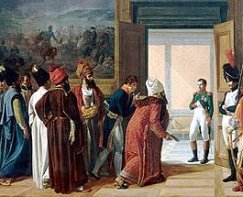 In the beginning of April Napoleon set up his headquarters at Finkenstein
(Le château de Finkenstein ) near Osterode, in East Prussia, now part of Poland.
He was to stay there for few weeks.
"I have just moved my headquarters to a very fine château, rather like the one which belongs to Bessières.
Here I have many fireplaces, and this is something I like very much; since I often get up in
the night, I like to see a fire burning. My health is perfect."
In the beginning of April Napoleon set up his headquarters at Finkenstein
(Le château de Finkenstein ) near Osterode, in East Prussia, now part of Poland.
He was to stay there for few weeks.
"I have just moved my headquarters to a very fine château, rather like the one which belongs to Bessières.
Here I have many fireplaces, and this is something I like very much; since I often get up in
the night, I like to see a fire burning. My health is perfect."
On 4th May France and Persia signed the Treaty of Finkenstein. Napoleon dispatched General Gardanne
to Tehran. For Napoleon, the Persian alliance served a dual purpose. While it created a temporary diversion against Russia, it also threatened British interests in India.
"France guaranteed Persia's territorial integrity and acknowledged her legitimate rights to Georgia, from which, and from all
other Persian territory, France would make every effort to drive Russia." (- Iradj Khan )
"Everything leads to the belief
that the enemy is on the move."
- Napoleon
In summer the country was superb. The rye, oat and wheat was high, the roadsides were planted with
willows and the villages were well-built. There were many lakes and forests. The French cavalry patrols
noticed some activity on the Russian side.
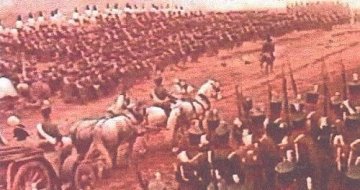 The Emperor wrote: "Everything leads to the belief that the enemy is on the move,
though it is ridiculous on his part to engage in a general action now that Danzig is
taken ..." The Russians attacked French advance posts.
Napoleon left Finkenstein riding in a carriage and escorted by the cavalry of Imperial Guard.
He wrote to Marshal Bernadotte: "I have yet to deduce what the enemy was trying to do. The whole thing had a smell of a rash move.
The Emperor wrote: "Everything leads to the belief that the enemy is on the move,
though it is ridiculous on his part to engage in a general action now that Danzig is
taken ..." The Russians attacked French advance posts.
Napoleon left Finkenstein riding in a carriage and escorted by the cavalry of Imperial Guard.
He wrote to Marshal Bernadotte: "I have yet to deduce what the enemy was trying to do. The whole thing had a smell of a rash move.
In early June, General Bennigsen decided to attack the advanced corps of Marshal Ney in East Prussia.
His plan for the destruction of Ney was very complicated. The scheme had in its favor the
fact that Ney his front being surrounded by woods, could not see what was going on at any
considerable distance.
Nevertheless, Ney obtained sufficient information from his cavalry to convince him that
some serious movements were in progress before fim. He requested Soult to support his left
and Davout to strengthen his position at Bergfried on the right.
Bennigsen postponed the movement till the 5th. Then he took on the offensive and after
several small engagements had expanded its force and came to a standstill.
The Emperor had not been idle, he ordered the Guard cavalry to assemble at Finkenstein,
and sent orders to his marshals. His design now was, to cut the Russian army from
the Baltic Sea and Koenigsberg and its resources. On the 9th, the French troops
occupied these positions:
- Marshal Soult's corps was at Altkirch
- Marshal Davout held the left bank of the Alle River above Guttstadt
- Marshal Ney's corps was at Guttstadt
- Marshal Murat's Reserve Cavalry was at Guttstadt
- the Guard was at Guttstadt
- Marshal Mortier was approaching Guttstadt
 Bennigsen was furious at Ney's miraculous getaway: outnumbered by 3 : 1, it was an easy
victory for the Russians. Fuming Bennigsen blamed Sacken for allowing Ney to escape.
Next, Bennigsen fell victim to a French ploy that stopped his advance in its tracks.
The Russian general received a captured dispatch, addressed to Ney, stating that Davout's
corps is about to fall on Bennigsen's rear. Thrown into a panic, Bennigsen shifts into reverse, ordering a retreat.
First he marched to Guttstadt, and then to Heilsberg. But the dispatch is bogus, planted on the Russians
in an effort to save Ney.
Bennigsen was furious at Ney's miraculous getaway: outnumbered by 3 : 1, it was an easy
victory for the Russians. Fuming Bennigsen blamed Sacken for allowing Ney to escape.
Next, Bennigsen fell victim to a French ploy that stopped his advance in its tracks.
The Russian general received a captured dispatch, addressed to Ney, stating that Davout's
corps is about to fall on Bennigsen's rear. Thrown into a panic, Bennigsen shifts into reverse, ordering a retreat.
First he marched to Guttstadt, and then to Heilsberg. But the dispatch is bogus, planted on the Russians
in an effort to save Ney.
"Bennigsen, having failed in this attempt at a surprise stroke, had nothing to do but fall back along
the main road which leads to Konigsberg, for his numbers were inferior to those which the
Emperor could bring now against him ... On the other hand he felt fairly sure ... of being able to maintain
the defensive indefinitely as he so fell back ... first of all he had heavily
fortified Heilsberg, a place on the main road ... and next because he had proved during
all the winter fighting the stubbornness of the Russian line." (- Hilaire Belloc)
On other fronts in 1807.
The Embargo Act was passed by the US Congress.
It was partly brought upon by the 'Chesapeake Incident'
and partly by Britain prohibiting on her trading partners
from trading with France.
Not only France and Russia were busy on the diplomatic and military field in 1807.
In March the US Congress passes an act to "prohibit the importation of slaves into any port or place within the
jurisdiction of the USA ... from any foreign kingdom, place, or country."
Slave trade is abolished in Great Britain.
George Canning (ext.link) becomes British minister of Foreign Affairs.
 In March 16th 1807 the Royal Navy and 5.000 redcoats under General A. Mackenzie Fraser invaded
and occupied Alexandria in Egypt. The aim was to secure the port as a base for Mediterranean
operations and to prevent the French from taking advantage of it.
The action however not only alienated Russian allies but was also a military catastrophe,
with Fraser losing two battles at Rosetta (modern Rashid) on 29 March and 21 April.
The crushed battalions suffered "almost 1.400 casualties". It forced the British to
abandon the idea of expanding the conquered territory, and they were confined only to the city. Agreement to leave Egypt was signed
in September, 1807.
In March 16th 1807 the Royal Navy and 5.000 redcoats under General A. Mackenzie Fraser invaded
and occupied Alexandria in Egypt. The aim was to secure the port as a base for Mediterranean
operations and to prevent the French from taking advantage of it.
The action however not only alienated Russian allies but was also a military catastrophe,
with Fraser losing two battles at Rosetta (modern Rashid) on 29 March and 21 April.
The crushed battalions suffered "almost 1.400 casualties". It forced the British to
abandon the idea of expanding the conquered territory, and they were confined only to the city. Agreement to leave Egypt was signed
in September, 1807.
On 27th May, the Sultan Selim III was overthrown and replaced by Mustafa IV.
His troops felt that the Sultan's anti-Islamic (ext.link) reforms were directly responsible for the
decline of the Ottoman empire. A mutiny in part of the Turkish army ensued.
 The Embargo Act was passed by the US Congress, during the second term of President Jefferson. (ext.link) It was partly brought
upon by the 'Chesapeake Incident' involving Britain attacking a U.S. ship, (in June the British board USS Chesapeake)
and partly by Britain prohibiting on her trading partners from trading with France.
The Embargo Act was passed by the US Congress, during the second term of President Jefferson. (ext.link) It was partly brought
upon by the 'Chesapeake Incident' involving Britain attacking a U.S. ship, (in June the British board USS Chesapeake)
and partly by Britain prohibiting on her trading partners from trading with France.
Britain and France were at war; the U.S. was neutral and trading with both sides. Both sides tried to hinder
American trade with the other. Jefferson's goal was to use economic warfare to secure American rights,
instead of military warfare. Initially, these acts sought to punish the British for its violation of American rights on the high seas;
among these was the impressment of those sailors off American ships, sailors who claimed to be American citizens but not
in the opinion or to the satisfaction of the Royal Navy, ever on the outlook for deserters.
In July take place the disastrous British attack on Buenos Aires. (ext.link)
In September, after a Danish refusal to surrender their biggest city, Copenhagen,
to the British, the warships bombarded the place killing 2.000 civilians and destroying 30 %
of the buildings. Then during armistice they carried off the Danish fleet and "all the naval
stores in the arsenal."
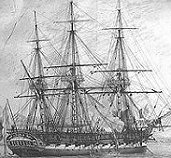 In September 1807, British ambassador from Constantinopole, Arbuthnot, had already pressed
for warships to be sent to bully the Turks. Admiral Collingwood sent number of ships to the
Dardanelles and shortly after this the British Cabinet decided to send Vice-Admiral Duckworth
with more ships to the Turkish capital "to demand the immediate surrender of the Turkish
Fleet , together with that of supply of naval stores from the arsenal ..."
In September 1807, British ambassador from Constantinopole, Arbuthnot, had already pressed
for warships to be sent to bully the Turks. Admiral Collingwood sent number of ships to the
Dardanelles and shortly after this the British Cabinet decided to send Vice-Admiral Duckworth
with more ships to the Turkish capital "to demand the immediate surrender of the Turkish
Fleet , together with that of supply of naval stores from the arsenal ..."
The Turks however showed no signs of being intimidated. They cannonaded the British forcing
them to a hastily retreat on March 3rd. The British barely escaped being battered by 300
cannons. This military action ended up in humiliation.
In 1807 in Austria everything was relatively quiet.
In 1807 Portugal refused Napoleon's demand to accede to the Continental System of embargo against Great Britain,
a French invasion under Junot followed, and Lisbon was captured.
British intervention in the Peninsular War restored Portuguese independence.
|

 1.
1. 
 Negotiations between France, Britain and Russia, during the early months of 1806, broke down.
Prussia had been lashed to fury by the discovery that Napoleon had attempted to bribe Britain
with Hanover, which he had so recently ceded to Prussia.
Wishing to strike her before succour reach her from Russia, Napoleon anticipated her
ultimatum by marching against her towards the Elbe River.
Negotiations between France, Britain and Russia, during the early months of 1806, broke down.
Prussia had been lashed to fury by the discovery that Napoleon had attempted to bribe Britain
with Hanover, which he had so recently ceded to Prussia.
Wishing to strike her before succour reach her from Russia, Napoleon anticipated her
ultimatum by marching against her towards the Elbe River.
 Loraine Petre described the French troops during the campaign in Eastern Prussia and Poland.
He wrote: "The rank and file of the army was but little, if at all, past its best.
In the earlier part of the campaign, its youngest men were the conscripts of 1806 who had, owing to their premature enrolment,
already undergone a years' training. Many of the troops had been with Napoleon in his
earlier campaigns and in Egypt, very many had been at Ulm and Austerlitz, the majority had just emerged from the
briliant campaign of Jena.
Loraine Petre described the French troops during the campaign in Eastern Prussia and Poland.
He wrote: "The rank and file of the army was but little, if at all, past its best.
In the earlier part of the campaign, its youngest men were the conscripts of 1806 who had, owing to their premature enrolment,
already undergone a years' training. Many of the troops had been with Napoleon in his
earlier campaigns and in Egypt, very many had been at Ulm and Austerlitz, the majority had just emerged from the
briliant campaign of Jena.
 Loraine Petre described the theatre of war: "... a country for the most part flat, marshy, and thickly wooded
- a country resembling, except in the last respect, the broads of Suffolk and Norfolk.
There are no heights of any importance, and it is only in the north-western corner ... that
it is possoble to describe the country as anything by an undulating plain.
Here the underying rock of the Polish plain crops out, and gives rise to hills which, in places,
reach the elevation of 500 to 700 feet above the sea, amongst which are imbedded the lakes
... "
Loraine Petre described the theatre of war: "... a country for the most part flat, marshy, and thickly wooded
- a country resembling, except in the last respect, the broads of Suffolk and Norfolk.
There are no heights of any importance, and it is only in the north-western corner ... that
it is possoble to describe the country as anything by an undulating plain.
Here the underying rock of the Polish plain crops out, and gives rise to hills which, in places,
reach the elevation of 500 to 700 feet above the sea, amongst which are imbedded the lakes
... "
 Marshal Murat entered Warsaw to a rapturous welcome.
He was feted by the Poles igniting vain hopes of future kingship.
"In the 16th century Poland had been one of the most powerful countries in Europe ...
within the space of 200 years, however, Poland had been eclipsed by its neighbours ...
Soon the country's history culture and language were extinguished and its very name abolished. In this way was the white eagle of Poland devoured
by the three black eagles of Prussia, Russia, and Austria. ... Meanwhile the Poles looked for
France, with its revolutionary ideas of Liberty,
Equality and Fraternity, as a beacon of hope. The fact France's enemies happened to be Poland's
oppressors was an obvious attraction, and many Polish soldiers volunteered for service in the
French army." (Summerville - "Napoleon's Polish Gamble" p 15)
Marshal Murat entered Warsaw to a rapturous welcome.
He was feted by the Poles igniting vain hopes of future kingship.
"In the 16th century Poland had been one of the most powerful countries in Europe ...
within the space of 200 years, however, Poland had been eclipsed by its neighbours ...
Soon the country's history culture and language were extinguished and its very name abolished. In this way was the white eagle of Poland devoured
by the three black eagles of Prussia, Russia, and Austria. ... Meanwhile the Poles looked for
France, with its revolutionary ideas of Liberty,
Equality and Fraternity, as a beacon of hope. The fact France's enemies happened to be Poland's
oppressors was an obvious attraction, and many Polish soldiers volunteered for service in the
French army." (Summerville - "Napoleon's Polish Gamble" p 15)
 Napoleon entered Warsaw in 1807 and French eagles soared over the Vistula. The Emperor
was hesitant about reenacting the Kingdom of Poland. In spite of the ovations given him
by the Poles, he wrote: "Only God can arbitrate this vast political problem ... It would
mean blood, more blood, and srtill more blood ..."
Napoleon entered Warsaw in 1807 and French eagles soared over the Vistula. The Emperor
was hesitant about reenacting the Kingdom of Poland. In spite of the ovations given him
by the Poles, he wrote: "Only God can arbitrate this vast political problem ... It would
mean blood, more blood, and srtill more blood ..."
 The news from France were not good. The slaughter at Eylau (see picture) had had the worst effect.
The military police combed the rear areas to round-up deserters.
The news from France were not good. The slaughter at Eylau (see picture) had had the worst effect.
The military police combed the rear areas to round-up deserters.
 Georges Blond gave somehow misleading description of the siege of Dirschau.
Dirschau stands on the west bank of the Vistula protecting the approaches to Danzig.
"The Poles in the Grande Armee had wantonly wrecked the small town of Dirschau
because it had been defended by Prussians - only 500 of them, but General Dombrowski [sic] had first battered it with artillery.
Then the Polish troops had opened fire indiscriminately on both the enemy and the population.
Some houses remained miraculously intact amid the carnage." ( Georges Blond - "La Grande Armee"
p 146)
Georges Blond gave somehow misleading description of the siege of Dirschau.
Dirschau stands on the west bank of the Vistula protecting the approaches to Danzig.
"The Poles in the Grande Armee had wantonly wrecked the small town of Dirschau
because it had been defended by Prussians - only 500 of them, but General Dombrowski [sic] had first battered it with artillery.
Then the Polish troops had opened fire indiscriminately on both the enemy and the population.
Some houses remained miraculously intact amid the carnage." ( Georges Blond - "La Grande Armee"
p 146)
 Danzig was besieged by Marshal Lefebvre's troops. Napoleon sent him an engineer,
Chasseloup, and a fine gunner, Jean-Ambroise-Baston comte de Lariboisière.
Danzig was besieged by Marshal Lefebvre's troops. Napoleon sent him an engineer,
Chasseloup, and a fine gunner, Jean-Ambroise-Baston comte de Lariboisière.
 Finally the Russo-Prussian garrison made a sortie in force.
Lefebvre went flailing happily into the middle of the uproar, pushing aside
the grenadiers who tried to shield him: "Come on my lads ! This I understand !" :-)
Finally the Russo-Prussian garrison made a sortie in force.
Lefebvre went flailing happily into the middle of the uproar, pushing aside
the grenadiers who tried to shield him: "Come on my lads ! This I understand !" :-)
 In the beginning of April Napoleon set up his headquarters at Finkenstein
(Le château de Finkenstein ) near Osterode, in East Prussia, now part of Poland.
He was to stay there for few weeks.
"I have just moved my headquarters to a very fine château, rather like the one which belongs to Bessières.
Here I have many fireplaces, and this is something I like very much; since I often get up in
the night, I like to see a fire burning. My health is perfect."
In the beginning of April Napoleon set up his headquarters at Finkenstein
(Le château de Finkenstein ) near Osterode, in East Prussia, now part of Poland.
He was to stay there for few weeks.
"I have just moved my headquarters to a very fine château, rather like the one which belongs to Bessières.
Here I have many fireplaces, and this is something I like very much; since I often get up in
the night, I like to see a fire burning. My health is perfect."
 The Emperor wrote: "Everything leads to the belief that the enemy is on the move,
though it is ridiculous on his part to engage in a general action now that Danzig is
taken ..." The Russians attacked French advance posts.
Napoleon left Finkenstein riding in a carriage and escorted by the cavalry of Imperial Guard.
He wrote to Marshal Bernadotte: "I have yet to deduce what the enemy was trying to do. The whole thing had a smell of a rash move.
The Emperor wrote: "Everything leads to the belief that the enemy is on the move,
though it is ridiculous on his part to engage in a general action now that Danzig is
taken ..." The Russians attacked French advance posts.
Napoleon left Finkenstein riding in a carriage and escorted by the cavalry of Imperial Guard.
He wrote to Marshal Bernadotte: "I have yet to deduce what the enemy was trying to do. The whole thing had a smell of a rash move.
 Bennigsen was furious at Ney's miraculous getaway: outnumbered by 3 : 1, it was an easy
victory for the Russians. Fuming Bennigsen blamed Sacken for allowing Ney to escape.
Next, Bennigsen fell victim to a French ploy that stopped his advance in its tracks.
The Russian general received a captured dispatch, addressed to Ney, stating that Davout's
corps is about to fall on Bennigsen's rear. Thrown into a panic, Bennigsen shifts into reverse, ordering a retreat.
First he marched to Guttstadt, and then to Heilsberg. But the dispatch is bogus, planted on the Russians
in an effort to save Ney.
Bennigsen was furious at Ney's miraculous getaway: outnumbered by 3 : 1, it was an easy
victory for the Russians. Fuming Bennigsen blamed Sacken for allowing Ney to escape.
Next, Bennigsen fell victim to a French ploy that stopped his advance in its tracks.
The Russian general received a captured dispatch, addressed to Ney, stating that Davout's
corps is about to fall on Bennigsen's rear. Thrown into a panic, Bennigsen shifts into reverse, ordering a retreat.
First he marched to Guttstadt, and then to Heilsberg. But the dispatch is bogus, planted on the Russians
in an effort to save Ney.
 In March 16th 1807 the Royal Navy and 5.000 redcoats under General A. Mackenzie Fraser invaded
and occupied Alexandria in Egypt. The aim was to secure the port as a base for Mediterranean
operations and to prevent the French from taking advantage of it.
The action however not only alienated Russian allies but was also a military catastrophe,
with Fraser losing two battles at Rosetta (modern Rashid) on 29 March and 21 April.
The crushed battalions suffered "almost 1.400 casualties". It forced the British to
abandon the idea of expanding the conquered territory, and they were confined only to the city. Agreement to leave Egypt was signed
in September, 1807.
In March 16th 1807 the Royal Navy and 5.000 redcoats under General A. Mackenzie Fraser invaded
and occupied Alexandria in Egypt. The aim was to secure the port as a base for Mediterranean
operations and to prevent the French from taking advantage of it.
The action however not only alienated Russian allies but was also a military catastrophe,
with Fraser losing two battles at Rosetta (modern Rashid) on 29 March and 21 April.
The crushed battalions suffered "almost 1.400 casualties". It forced the British to
abandon the idea of expanding the conquered territory, and they were confined only to the city. Agreement to leave Egypt was signed
in September, 1807.
 The Embargo Act was passed by the US Congress, during the second term of
The Embargo Act was passed by the US Congress, during the second term of  In September 1807, British ambassador from Constantinopole, Arbuthnot, had already pressed
for warships to be sent to bully the Turks. Admiral Collingwood sent number of ships to the
Dardanelles and shortly after this the British Cabinet decided to send Vice-Admiral Duckworth
with more ships to the Turkish capital "to demand the immediate surrender of the Turkish
Fleet , together with that of supply of naval stores from the arsenal ..."
In September 1807, British ambassador from Constantinopole, Arbuthnot, had already pressed
for warships to be sent to bully the Turks. Admiral Collingwood sent number of ships to the
Dardanelles and shortly after this the British Cabinet decided to send Vice-Admiral Duckworth
with more ships to the Turkish capital "to demand the immediate surrender of the Turkish
Fleet , together with that of supply of naval stores from the arsenal ..."
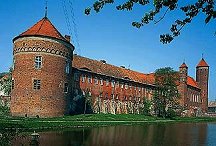 Heilsberg (Lidzbark) was a small town, situated on the left bank of the Alle River.
In Heilsberg stood an old Teutonic castle. For many years it was a residence
of the bishops of Warmia and a stronghold protecting the eastern border of their domain.
By the power of the Second Peace Treaty of Torun signed in 1466, Warmia was incorporated
into Poland. The year of 1772 brought the incorporation of Warmia into Prussia.
Heilsberg (Lidzbark) was a small town, situated on the left bank of the Alle River.
In Heilsberg stood an old Teutonic castle. For many years it was a residence
of the bishops of Warmia and a stronghold protecting the eastern border of their domain.
By the power of the Second Peace Treaty of Torun signed in 1466, Warmia was incorporated
into Poland. The year of 1772 brought the incorporation of Warmia into Prussia.



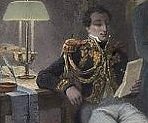

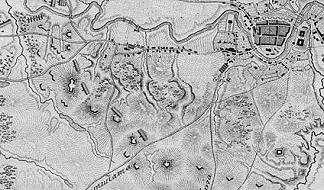 Left: Redoubt #1 on the northern bank of Alle River.
Left: Redoubt #1 on the northern bank of Alle River. The spearheading French troops are under Marshal Joahim Murat.
With his plumed hat, gold-braided uniform, and magnificent warhorse, Murat was the very
image of a cavalier. Behind Murat's cavalry is marching infantry and artillery.
Summerville writes: "The emperor, with the whole Grand Army in his wake, is riding towards the final showdown
with Bennigsen. It is time to make the Polish gamble pay off. ... Stretching miles to the
rear, his columns advance, toiling dusty dirt tracks in suffocating heat.
... Since Mohrungen, 15 miles west of Deppen, the troops have breathed the scent of war:
burning houses, rotting corpses. Napoleon finds Deppen a ruin, torched by Bennigsen
before turning tail for Guttstadt. ... Napoleon is delighted by developments ... "
(Summerville - "Napoleon's Polish Gamble" p 118)
The spearheading French troops are under Marshal Joahim Murat.
With his plumed hat, gold-braided uniform, and magnificent warhorse, Murat was the very
image of a cavalier. Behind Murat's cavalry is marching infantry and artillery.
Summerville writes: "The emperor, with the whole Grand Army in his wake, is riding towards the final showdown
with Bennigsen. It is time to make the Polish gamble pay off. ... Stretching miles to the
rear, his columns advance, toiling dusty dirt tracks in suffocating heat.
... Since Mohrungen, 15 miles west of Deppen, the troops have breathed the scent of war:
burning houses, rotting corpses. Napoleon finds Deppen a ruin, torched by Bennigsen
before turning tail for Guttstadt. ... Napoleon is delighted by developments ... "
(Summerville - "Napoleon's Polish Gamble" p 118)
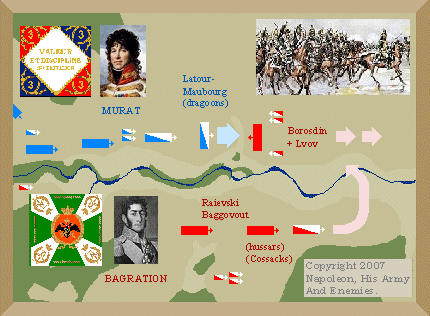 Meanwhile Bennigsen sent orders to Bagration who was retiring on the opposite side of the
river, to cross by the pontoon bridges and to move again up the north bank and fend off the
French. Bagration was himself here, there, and everywhere, directing, assisting, and
encouraging his jagers and cavalry.
Meanwhile Bennigsen sent orders to Bagration who was retiring on the opposite side of the
river, to cross by the pontoon bridges and to move again up the north bank and fend off the
French. Bagration was himself here, there, and everywhere, directing, assisting, and
encouraging his jagers and cavalry.
 Uvarov placed three jager regiments in the wood near Lawden, and sent cavalry under
Kozhin and Fock across the Spuibach just as Bagration's troops were slowly faling back.
Uvarov placed three jager regiments in the wood near Lawden, and sent cavalry under
Kozhin and Fock across the Spuibach just as Bagration's troops were slowly faling back.
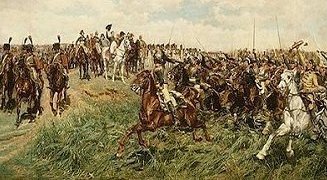 Murat rode to the front of the 3rd Heavy Cavalry Division and cried "Forward !"
The cuirassiers drew their sabers and advanced.
De Gonneville of the 6th Cuirassiers writes: "At this moment the grand duke of Berg (Murat)
came up to us; he came from our right rear, followed by his staff, passed at a gallop across
our front, bending forwards on his horse's neck, and as he passed at full speed by General Espagne, he flung at him one
word alone which I heard, "Charge !"
Murat rode to the front of the 3rd Heavy Cavalry Division and cried "Forward !"
The cuirassiers drew their sabers and advanced.
De Gonneville of the 6th Cuirassiers writes: "At this moment the grand duke of Berg (Murat)
came up to us; he came from our right rear, followed by his staff, passed at a gallop across
our front, bending forwards on his horse's neck, and as he passed at full speed by General Espagne, he flung at him one
word alone which I heard, "Charge !"
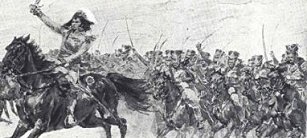 Murat charged with a headlong rashness but his horse was struck by canister.
Horse and rider were knocked over together like a stand of muskets. Murat - now without one
boot, it was stuck in the strirup of killed horse - quickly mounted another horse.
He took the entire brigade led by Pajol and advanced against the enemy.
Uvarov's cavalry was of high quality and the fresh reinforcements brought by
Murat changed little. The French continued to suffer heavy casualties and the
battle continued. Colonel Dery and several other officers were wounded.
Murat charged with a headlong rashness but his horse was struck by canister.
Horse and rider were knocked over together like a stand of muskets. Murat - now without one
boot, it was stuck in the strirup of killed horse - quickly mounted another horse.
He took the entire brigade led by Pajol and advanced against the enemy.
Uvarov's cavalry was of high quality and the fresh reinforcements brought by
Murat changed little. The French continued to suffer heavy casualties and the
battle continued. Colonel Dery and several other officers were wounded.
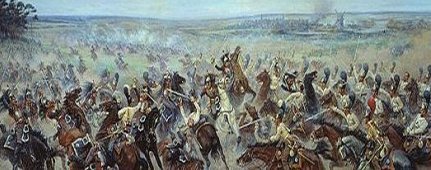 Murat's 6.000-9,000 cavalrymen were thrown back by 3,000-4,500 Russians and Prussians.
By day's end, each cavalryman sabre will be dripping with blood.
Murat's 6.000-9,000 cavalrymen were thrown back by 3,000-4,500 Russians and Prussians.
By day's end, each cavalryman sabre will be dripping with blood.
 This is a photo of the northern part of the battlefield at Heilsberg (Lidzbark Warminski today).
View from position of Legrand’s infantry and Murat’s cavalry (from the Lawden forest)
on the Russian positions. Somewhere here took place large cavalry battle.
Photo taken in 2002 by Jan Kowalik.
This is a photo of the northern part of the battlefield at Heilsberg (Lidzbark Warminski today).
View from position of Legrand’s infantry and Murat’s cavalry (from the Lawden forest)
on the Russian positions. Somewhere here took place large cavalry battle.
Photo taken in 2002 by Jan Kowalik.
 Napoleon watched the raging battle, hunched over the mane of his horse.
He was surrounded by generals and staff officers, they sat motionless on their horses.
They could hear the rumble of the cannonade and pillars of smoke rose into the air.
Napoleon watched the raging battle, hunched over the mane of his horse.
He was surrounded by generals and staff officers, they sat motionless on their horses.
They could hear the rumble of the cannonade and pillars of smoke rose into the air.
 Marshal Murat met Savary and insisted that the guardsmen attack with bayonet.
Savary was annoyed with Murat's actions: "It would be better for us if he (Murat)
was less brave and had a little more common sense." Savary's guardsmen loaded their
muskets and cannons and opened fire at close range.
Marshal Murat met Savary and insisted that the guardsmen attack with bayonet.
Savary was annoyed with Murat's actions: "It would be better for us if he (Murat)
was less brave and had a little more common sense." Savary's guardsmen loaded their
muskets and cannons and opened fire at close range.
 Bagration was the master of rear-guard or advance-guard fighting, and was a tactically aggressive commander.
In April 1799 Bagration captured Brescia in Italy, then he defeated French General Serurier
and forced another commander, Moreau, to retreat to Marengo. At Trebia he led the
advance guard. In 1805 Bagration again commanded advance guard of Kutuzov's army and then during retreat
took command over the rear guard. Prince Bagration was placed in the most dangerous situations, where it would be necessary
to fight against overwhelming odds. His heroics in 1806-1807 as rear-guard commander are well-known
in Russia.
Bagration was the master of rear-guard or advance-guard fighting, and was a tactically aggressive commander.
In April 1799 Bagration captured Brescia in Italy, then he defeated French General Serurier
and forced another commander, Moreau, to retreat to Marengo. At Trebia he led the
advance guard. In 1805 Bagration again commanded advance guard of Kutuzov's army and then during retreat
took command over the rear guard. Prince Bagration was placed in the most dangerous situations, where it would be necessary
to fight against overwhelming odds. His heroics in 1806-1807 as rear-guard commander are well-known
in Russia.
 Cyr's division was replaced with St.Hilaire's division.
About 3 PM Saint-Hilaire went into action. Senior officers, riding out in front
of the ranks with their sabers unsheathed, barked out orders and words that even
Russian veterans remembered having heard many times and that always made a deep
impression on them. The infantry marched through the fields, in cadence with the
monotonous roll of the drums and took Bewernick. The Russians were awed by such
bravery.
Cyr's division was replaced with St.Hilaire's division.
About 3 PM Saint-Hilaire went into action. Senior officers, riding out in front
of the ranks with their sabers unsheathed, barked out orders and words that even
Russian veterans remembered having heard many times and that always made a deep
impression on them. The infantry marched through the fields, in cadence with the
monotonous roll of the drums and took Bewernick. The Russians were awed by such
bravery.
 Grand Duke Constantine established a mighty battery on the right bank of the Alle River
and pounded St.Cyr's and St.Hilaire's troops. This magnificient battery was commanded by
Diebich or Diebitzsch - in early 1830s commander of the Russian army.
Grand Duke Constantine established a mighty battery on the right bank of the Alle River
and pounded St.Cyr's and St.Hilaire's troops. This magnificient battery was commanded by
Diebich or Diebitzsch - in early 1830s commander of the Russian army.
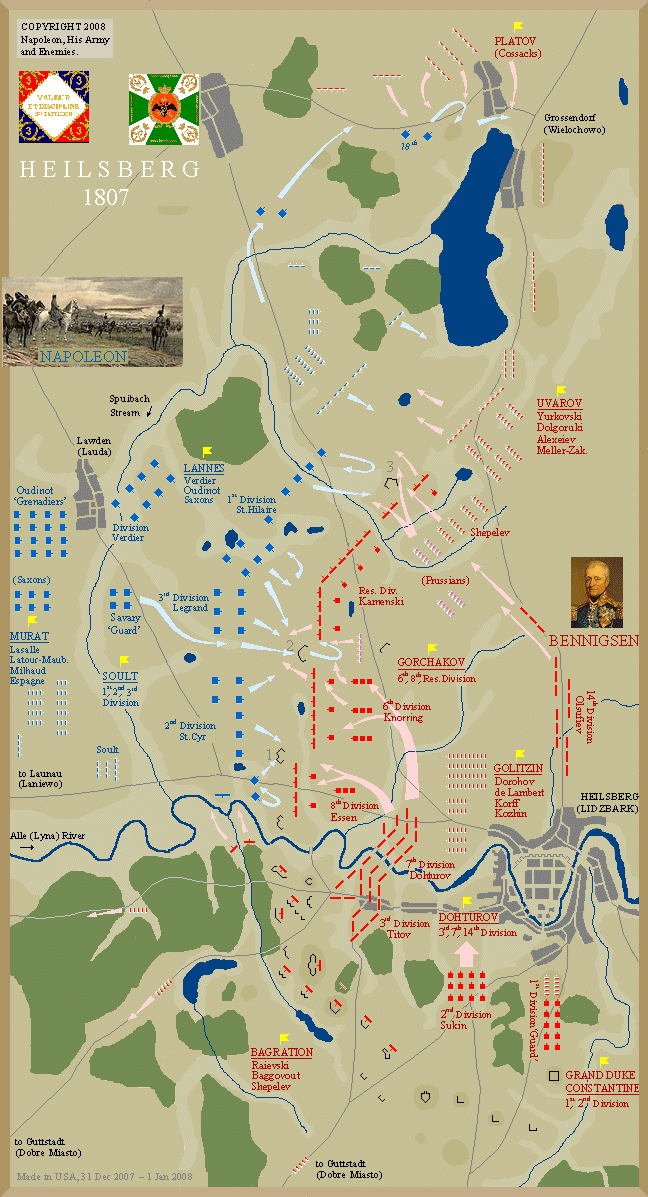
 Up and down the line, men were reeling and falling, horses plunging and mad with wounds,
the men yelling, shells bursting, it was as if the last day of Pompei.
The cannonballs were throwing up chunks of soil where they struck.
Smoke, splinters, blood, wreck and carnage were indescribable.
Up and down the line, men were reeling and falling, horses plunging and mad with wounds,
the men yelling, shells bursting, it was as if the last day of Pompei.
The cannonballs were throwing up chunks of soil where they struck.
Smoke, splinters, blood, wreck and carnage were indescribable.
 The French infantry rushed forward as it was intolerable to stay under such
cannonade. On the columns pushed, closing the gaps, dressing the line, their
pace breaking into a run as they neared the earthworks under a galling fire.
The French infantry rushed forward as it was intolerable to stay under such
cannonade. On the columns pushed, closing the gaps, dressing the line, their
pace breaking into a run as they neared the earthworks under a galling fire.
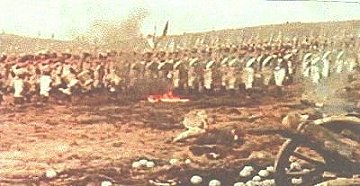 GL Knorring's 6th Divison, GM Titov's 3rd Divison, and Sukin's 2nd Division attacked
along their fronts.
Shikanov mentions two other musketier regiments advanced with the 2nd Division. The
French held their ground with musketry and artillery fire.
Once the advancing Russian columns halted under the murderous fire,
the 10th Light, 43rd, and 46th counter-attacked. The 57th Line (nicknamed "The Terrible") also
charged with bayonet. They pushed the Russians back but were shattered by canister and fell
back.
GL Knorring's 6th Divison, GM Titov's 3rd Divison, and Sukin's 2nd Division attacked
along their fronts.
Shikanov mentions two other musketier regiments advanced with the 2nd Division. The
French held their ground with musketry and artillery fire.
Once the advancing Russian columns halted under the murderous fire,
the 10th Light, 43rd, and 46th counter-attacked. The 57th Line (nicknamed "The Terrible") also
charged with bayonet. They pushed the Russians back but were shattered by canister and fell
back.
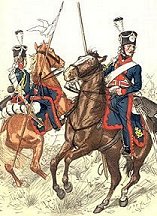 The Russian musketeers and Prussian cavalry (Ziethen's dragoons and Towarzysze Regiment)
rushed after the fleeing French.
The fleeing French infantry run in the direction of Lawden Wood where stood GdD d'Espagne's
3rd Cuirassier Division. The cuirassiers became disordered and fled too.
The Russian musketeers and Prussian cavalry (Ziethen's dragoons and Towarzysze Regiment)
rushed after the fleeing French.
The fleeing French infantry run in the direction of Lawden Wood where stood GdD d'Espagne's
3rd Cuirassier Division. The cuirassiers became disordered and fled too.
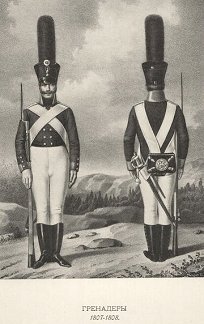 The 55th Line was attacked by Prussian cavalry and Russian infantry and was overthrown.
They also lost their eagle, colonel, and number of officers.
The eagle of 55th Line Regiment was captured by NCO Anton Antonov of Pernov Musketeers.
After war the Pernov was awarded with georgievskiie znamenia.
The 55th Line was attacked by Prussian cavalry and Russian infantry and was overthrown.
They also lost their eagle, colonel, and number of officers.
The eagle of 55th Line Regiment was captured by NCO Anton Antonov of Pernov Musketeers.
After war the Pernov was awarded with georgievskiie znamenia.
 Prussian historians claimed that the Prittwitz Hussars captured the Eagle. German artist
Knotel painted a picture showing this moment. There is however no data, no names of Prussian
soldiers who captured the Eagle, no nothing to back up this claim. So it looks like the
Russians and not the Prussians did it.
Prussian historians claimed that the Prittwitz Hussars captured the Eagle. German artist
Knotel painted a picture showing this moment. There is however no data, no names of Prussian
soldiers who captured the Eagle, no nothing to back up this claim. So it looks like the
Russians and not the Prussians did it.
 Meanwhile arrived Marshal Lannes with his divisions. At about 10 PM he sent Verdier's
division from the Lawden Wood forward against the Redoubt #2. Warned by a French deserter of
the impending attack, Bennigsen was prepared to meet it.
Meanwhile arrived Marshal Lannes with his divisions. At about 10 PM he sent Verdier's
division from the Lawden Wood forward against the Redoubt #2. Warned by a French deserter of
the impending attack, Bennigsen was prepared to meet it.
 Napoleon entered the town of Heilsberg (see picture), and wrote a short letter to Marie
Countess Walewska and left.
(In 1807 Napoleon fell in love with a Polish aristocrat,
the Countess Walewska. She gave him a son, Alexandre, and remained faithful to him until
he was exiled.)
Napoleon entered the town of Heilsberg (see picture), and wrote a short letter to Marie
Countess Walewska and left.
(In 1807 Napoleon fell in love with a Polish aristocrat,
the Countess Walewska. She gave him a son, Alexandre, and remained faithful to him until
he was exiled.)
 Georges Blond writes: "Bennigsen, always as doleful as a sick dog, led his troops in
retreat along the right bank of the Alle River in the direction of Konigsberg."
Alle River makes a great bend to the east and north, so that the French, moving across the chord
while he followed the arc, were able to outstrip him.
Bennigsen crossed to the left bank of Alle only to find his way barred by
Marshal Lannes' corps. (See map --> )
Georges Blond writes: "Bennigsen, always as doleful as a sick dog, led his troops in
retreat along the right bank of the Alle River in the direction of Konigsberg."
Alle River makes a great bend to the east and north, so that the French, moving across the chord
while he followed the arc, were able to outstrip him.
Bennigsen crossed to the left bank of Alle only to find his way barred by
Marshal Lannes' corps. (See map --> )
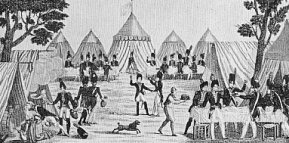 "The engineers had built a large wooden hut in which the officers of the Guard were to feast their
erstwhile opponents. On the 30th the sun shone briliantly in a cloudless sky. In a well-chosen meadow, a cannon-shot from the town, planks nailed to trestles formed
picninc tables for the 'brotherly feast', arranged around a square in which the band would play.
"The engineers had built a large wooden hut in which the officers of the Guard were to feast their
erstwhile opponents. On the 30th the sun shone briliantly in a cloudless sky. In a well-chosen meadow, a cannon-shot from the town, planks nailed to trestles formed
picninc tables for the 'brotherly feast', arranged around a square in which the band would play.
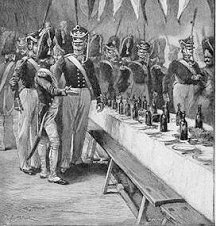 The Russians, initially suspicious and awkward, were
reassured by the French. Coignet has left a detailed account of this feast, and although he
may have exaggerated some details, he did so inadvertently, having written his memoirs more than 30 years after
leaving the service and one can understand that this was in no way a formal banquet.
The Russians, initially suspicious and awkward, were
reassured by the French. Coignet has left a detailed account of this feast, and although he
may have exaggerated some details, he did so inadvertently, having written his memoirs more than 30 years after
leaving the service and one can understand that this was in no way a formal banquet.
 The treaty ended war between Russia and France and began an alliance between the two empires
which rendered the rest of Europe almost powerless.
The treaty ended war between Russia and France and began an alliance between the two empires
which rendered the rest of Europe almost powerless.
